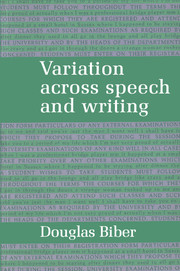Book contents
- Frontmatter
- Contents
- List of figures
- List of tables
- Acknowledgments
- Part I Background concepts and issues
- Part II Methodology
- Part III Dimensions and relations in English
- 6 Textual dimensions in speech and writing
- 7 Textual relations in speech and writing
- 8 Extending the description: variation within genres
- 9 Afterword: applying the model
- Appendix I Texts used in the study
- Appendix II Linguistic features: algorithms and functions
- Appendix III Mean frequency counts of all linguistic features in each genre
- Appendix IV Pearson correlation coefficients for all linguistic features
- References
- Index
9 - Afterword: applying the model
Published online by Cambridge University Press: 05 June 2012
- Frontmatter
- Contents
- List of figures
- List of tables
- Acknowledgments
- Part I Background concepts and issues
- Part II Methodology
- Part III Dimensions and relations in English
- 6 Textual dimensions in speech and writing
- 7 Textual relations in speech and writing
- 8 Extending the description: variation within genres
- 9 Afterword: applying the model
- Appendix I Texts used in the study
- Appendix II Linguistic features: algorithms and functions
- Appendix III Mean frequency counts of all linguistic features in each genre
- Appendix IV Pearson correlation coefficients for all linguistic features
- References
- Index
Summary
Overview of the study
The analysis presented here was undertaken to describe the relationship between speech and writing in English. Previous studies have offered a wide range of conclusions concerning this relationship; some studies conclude that speech and writing are not very different from a linguistic perspective, while others conclude that they are fundamentally different; some studies conclude that the differences between speech and writing are due to one set of features, while others focus on a different set of features. The present study sorts out these contradictory findings and arrives at an overall account of the textual relations in spoken and written English. To accomplish this task, the study analyzes the distribution of many functionally diverse linguistic features in many different types of spoken and written texts. This analysis shows that there is no single, absolute difference between speech and writing in English; rather there are several dimensions of variation, and particular types of speech and writing are more or less similar with respect to each dimension. In all, six dimensions of variation are identified here, which are interpreted in functional terms and labelled: Dimension 1: ‘Involved versus Informational Production’, Dimension 2: ‘Narrative versus Non-Narrative Concerns’, Dimension 3: ‘Explicit versus Situation-Dependent Reference’, Dimension 4: ‘Overt Expression of Persuasion’, Dimension 5: ‘Abstract versus Non-Abstract Information’, and Dimension 6: ‘On-Line Informational Elaboration’.
- Type
- Chapter
- Information
- Variation across Speech and Writing , pp. 199 - 207Publisher: Cambridge University PressPrint publication year: 1988

